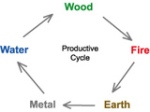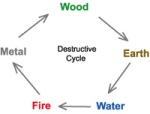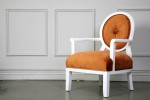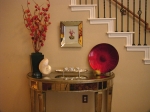
Can you spot the Five Elements in this photo? Scroll down for answers.
Feng Shui is based upon the principles of Yin and Yang. Yin and Yang are the parents of “the five elements”. The five elements — fire, earth, metal, water, and wood are used in Feng Shui to create balance and harmony. The elements describe different types of energy (qi) and can be thought of as “five phases” because energy is constantly moving and transforming. Everything in the world is created from a combination of the five phases. They are the building blocks which create the quality of energy present in a certain space.
Why is this important? Because when energy is balanced, you’ll feel relaxed and comfortable in a space producing a higher level of satisfaction with life.
The Five Elements and their Characteristics
| Element |
Quality |
Color |
Shape |
| Water |
Flows, falls |
Black, Blue |
Wavy |
| Earth |
Compacts |
Yellow, Brown |
Square, Cubic |
| Wood |
Grows upward |
Green, Turqouise |
Rectangular |
| Metal |
Contracts |
White, Gold, Silver |
Round, Spherical |
| Fire |
Radiates |
Red, Orange, Purple |
Triangular |
The goal of Feng Shui is to balance the elements in an environment so that they don’t conflict with each other. Using color, shape, furniture arrangement and space planning, a Feng Shui practitioner arranges the elements a harmonious way and makes the unseen, seen. The qualities of each element is manifested in its color, material, and shape. However, you’ll rarely find an element that’s just a single element – most things consist of a combination of elements. For example, when we use the term wood qi, it means that it has a preponderance of wood qi, not that it is only wood qi.
How to Balance the Elements
The correct use of elements will create the productive cycle. The productive cycle means the elements are not overpowering one another. The space will feel comfortable and look appealing. The productive cycle works like this:
 Water nurtures -> Wood nurtures -> Fire nurtures -> Earth nurtures -> Metal nurtures -> Water.
Water nurtures -> Wood nurtures -> Fire nurtures -> Earth nurtures -> Metal nurtures -> Water.
In contrast, using too much or too little of an element causes conflict between the different energies which causes unbalanced qi. This is known as the destructive cycle. The destructive cycle works like this:
Water weakens -> Fire weakens –> Metal weakens -> Wood weakens –> Earth weakens –> Water.

Applying the Principles to a Room
At the most basic level, if you have a room with a pitched ceiling, painted red, with white furniture and white drapes containing circular-shaped pattern, the room will have a lot of fire and metal qi. Why? Because red is a fire color, and the pitched ceiling is a fire element (triangular), white is metal color and circles are metal shapes. Fire is destructive to metal. The elements are following the destructive cycle. This is undesirable and the unseen conflict between fire and metal can cause you discomfort in the room.
How to move into the Productive Cycle?
Add rounded-leaf plants in square-shaped pots to add earth, wood, and water energy. Earth energy is found in the dirt and the square-shaped pot. Wood energy manifests from the color green and from the very nature of the plant. Water energy is found in the curved shape of the leaves. Adding the missing elements buffers the conflict between metal and fire and creates the productive cycle.
Going Deeper
A Feng Shui practitioner would go deeper and do more a thorough analysis before making recommendations by asking these questions:
- First, what type of inherent energy is found in the room? This is based on the compass reading of the room and charting of the natal chart or flying-star chart. (“Star” meaning energy)
- Second, what is the room used for? Recommendations for a bedroom will be different than for the dining room. You need to determine the quality of energy needed in the room based on its usage. For example, earth energy in a bedroom is desirable because it is grounding and can help you relax. In an office, too much earth can make you lethargic and not wanting to work.
- Third, what is the birth-year energy (or ming-gua) of the people who will be using the room? If you are a water element the best elements for your bedroom are water energy and metal energy (metal creates water). Yet that doesn’t necessarily mean that you need to add these elements if they are already inherently in the room.
The goal of Feng Shui is to create balance and harmony through correct energy balancing. When a room is balanced energetically odds are you’ll feel it as you walk in. If you get the feeling of peace and feel like relaxing your shoulders look around and see if you can spot how the five elements are used in the room. Intuitively, we all can feel when a space is balanced.

Can you spot the Five Elements in this photo?
Water – the curved arms of the chair; the color of the floor (black).
Wood – the inherent material used in constructing the chair; the shape of the chair legs.
Fire – the color of the upholstery (orange).
Earth – the square-shape of the squares on the wall; the shape of the bottom chair cushion.
Metal – the color the chair was painted (white); the circular back of the chair; the color of the wall (grey).
 In small environments use color and furniture arrangement to keep the space open and energy flowing. Using the same colors throughout, but in different shades you can create a harmonious space with great Feng Shui. Using the tips below will help your space feel open and in balance.
In small environments use color and furniture arrangement to keep the space open and energy flowing. Using the same colors throughout, but in different shades you can create a harmonious space with great Feng Shui. Using the tips below will help your space feel open and in balance. 7- If you don’t have a foyer by your front door create one by placing a rectangular or circular area rug in front of the door and a console table on the wall closest to the front door with a square or rectangular-shaped piece of art above it. (A mirror would work well too).
7- If you don’t have a foyer by your front door create one by placing a rectangular or circular area rug in front of the door and a console table on the wall closest to the front door with a square or rectangular-shaped piece of art above it. (A mirror would work well too).










